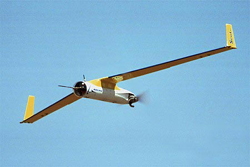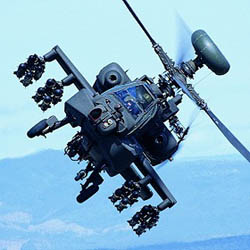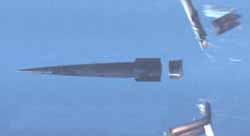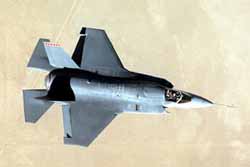Daily News
by Gail Helmer
[ Send Us News | Archives ]
Boeing ScanEagle UAV Makes First Autonomous Flight
ScanEagle, a Boeing long-endurance unmanned aerial vehicle or UAV, successfully made its first autonomous flight Wednesday at the company's Boardman test facility in eastern Oregon. The UAV, built by The Insitu Group, took off via a pneumatic catapult and flew a pre-programmed course at a maximum altitude of 1,500 feet.
During the 45-minute flight, ScanEagle completed a number of test points using the Global Positioning System. The test team also demonstrated the ability to make real-time updates to the flight plan from the ground station. The UAV was retrieved using the patented SkyHook technique, in which the ScanEagle catches a rope hanging from a 30-foot-high pole.

The four-foot long vehicle, which has a 10-foot wingspan and can fly up to 68 knots, was built using systems automation, integration, communications and payload technologies applicable to a variety of Boeing unmanned systems.
In February 2002, Boeing signed a 15-month agreement with Insitu to develop the ScanEagle UAV. ScanEagle is based on Insitu's Seascan aircraft, a ship-based surveillance platform. In 1998, Insitu and the University of Washington demonstrated the potential of these types of vehicles when they coordinated the first UAV transatlantic flight, a 2,000-mile trip from Newfoundland to Scotland that used only 1.5 gallons of gasoline.
Sixth U.S. Army Apache Longbow Combat-Ready
The U.S. Army's sixth AH-64D Apache Longbow attack helicopter battalion has been certified combat-ready after completing extensive training at Fort Hood, Texas. The battalion will return to Germany this summer as the first Apache Longbow unit to be stationed in Europe. The unit completed eight months of training in AH-64D Apache Longbow helicopters, built by Boeing in Mesa, Ariz. The battalion will be the U.S. Army's second unit based overseas.
The first international deployment of U.S. Army Apache Longbows occurred in October 2001 when the Army deployed a regiment to South Korea. The regiment's Apache helicopters, which had been in Korea as AH-64As, were remanufactured and returned to duty in their next-generation configuration.

Additionally, U.S. Army Apache Longbows deployed to the Middle East in 2002 in support of Operation Desert Spring. Apache helicopters are fielded around the world including the U.S. Army's deployment to Afghanistan for Operation Anaconda, the war against terrorism.
The U.S. Army is modernizing its fleet of AH-64A Apaches into next-generation Apache Longbow helicopters which link a wide range of avionics, electronics and weapons into one fully-integrated weapons system.
ATK Flies Navy Gun-Launched Projectile to World Record
An industry team led by ATK achieved a planned, significant milestone in the development of a transformational stand-off combat capability -- long- range precision-guided projectiles in support of ground maneuver warfare.

During a test conducted yesterday, an Autonomous Naval Support Round (ANSR) was fired over the Atlantic Ocean from the Wallops Island flight facility in southeastern Virginia. The round, fired from a 5"/62-caliber gun with high-performance EX-99 propellant, flew 62 miles (54 nautical miles). The ATK funded test was part of an ongoing ATK program to develop a ballistic trajectory, GPS-guided solution to U.S. Navy, Marine Corps, and Army requirements for affordable, long-range, precise artillery.
ANSR differs from other approaches in its simplicity and relatively low cost, as well as its application to various gun types and calibers. Unit cost in full-rate production is estimated to be less than $20,000. ANSR's application to the existing Navy inventory of 5"/54-caliber guns enables rapid introduction throughout the fleet, providing the Navy a break-through improvement in fire support capability.
Norway Joins Growing List of F-35 JSF Partners
The F-35 Joint Strike Fighter program added a new international partner today when Norway officially joined the JSF's System Development and Demonstration (SDD) phase. Becoming a part of the SDD phase qualifies Norwegian industry to bid for work on the program, and enables Norway to influence the F-35's design and mission.

"Norway is a valued ally with an astute technical capability that will benefit both the F-35 program and future pilots who fly the aircraft," said Tom Burbage, executive vice president and general manager of the Lockheed Martin JSF program. "With five international partners now on board, and more expected, this program is clearly fulfilling its promise of focusing the resources of multiple nations on a monumentally important defense capability."
The United Kingdom, the first non-U.S. participant in F-35 SDD, has been followed by Canada, Denmark, the Netherlands and Norway. Other countries evaluating participation in the F-35 program include Italy and Turkey. Since 1980, Norway has purchased and operated 74 Lockheed Martin F-16 fighters. The F-16 is among the aircraft the F-35 is designed to replace after 2010.
[ Send Us News | Archives ]
by Gail Helmer
Thursday June 20, 2002
- Boeing ScanEagle UAV Makes First Autonomous Flight
- Sixth U.S. Army Apache Longbow Combat-Ready
- ATK Flies Navy Gun-Launched Projectile to World Record
- Norway Joins Growing List of F-35 JSF Partners
Boeing ScanEagle UAV Makes First Autonomous Flight
ScanEagle, a Boeing long-endurance unmanned aerial vehicle or UAV, successfully made its first autonomous flight Wednesday at the company's Boardman test facility in eastern Oregon. The UAV, built by The Insitu Group, took off via a pneumatic catapult and flew a pre-programmed course at a maximum altitude of 1,500 feet.
During the 45-minute flight, ScanEagle completed a number of test points using the Global Positioning System. The test team also demonstrated the ability to make real-time updates to the flight plan from the ground station. The UAV was retrieved using the patented SkyHook technique, in which the ScanEagle catches a rope hanging from a 30-foot-high pole.

The four-foot long vehicle, which has a 10-foot wingspan and can fly up to 68 knots, was built using systems automation, integration, communications and payload technologies applicable to a variety of Boeing unmanned systems.
In February 2002, Boeing signed a 15-month agreement with Insitu to develop the ScanEagle UAV. ScanEagle is based on Insitu's Seascan aircraft, a ship-based surveillance platform. In 1998, Insitu and the University of Washington demonstrated the potential of these types of vehicles when they coordinated the first UAV transatlantic flight, a 2,000-mile trip from Newfoundland to Scotland that used only 1.5 gallons of gasoline.
Sixth U.S. Army Apache Longbow Combat-Ready
The U.S. Army's sixth AH-64D Apache Longbow attack helicopter battalion has been certified combat-ready after completing extensive training at Fort Hood, Texas. The battalion will return to Germany this summer as the first Apache Longbow unit to be stationed in Europe. The unit completed eight months of training in AH-64D Apache Longbow helicopters, built by Boeing in Mesa, Ariz. The battalion will be the U.S. Army's second unit based overseas.
The first international deployment of U.S. Army Apache Longbows occurred in October 2001 when the Army deployed a regiment to South Korea. The regiment's Apache helicopters, which had been in Korea as AH-64As, were remanufactured and returned to duty in their next-generation configuration.

Additionally, U.S. Army Apache Longbows deployed to the Middle East in 2002 in support of Operation Desert Spring. Apache helicopters are fielded around the world including the U.S. Army's deployment to Afghanistan for Operation Anaconda, the war against terrorism.
The U.S. Army is modernizing its fleet of AH-64A Apaches into next-generation Apache Longbow helicopters which link a wide range of avionics, electronics and weapons into one fully-integrated weapons system.
ATK Flies Navy Gun-Launched Projectile to World Record
An industry team led by ATK achieved a planned, significant milestone in the development of a transformational stand-off combat capability -- long- range precision-guided projectiles in support of ground maneuver warfare.

During a test conducted yesterday, an Autonomous Naval Support Round (ANSR) was fired over the Atlantic Ocean from the Wallops Island flight facility in southeastern Virginia. The round, fired from a 5"/62-caliber gun with high-performance EX-99 propellant, flew 62 miles (54 nautical miles). The ATK funded test was part of an ongoing ATK program to develop a ballistic trajectory, GPS-guided solution to U.S. Navy, Marine Corps, and Army requirements for affordable, long-range, precise artillery.
ANSR differs from other approaches in its simplicity and relatively low cost, as well as its application to various gun types and calibers. Unit cost in full-rate production is estimated to be less than $20,000. ANSR's application to the existing Navy inventory of 5"/54-caliber guns enables rapid introduction throughout the fleet, providing the Navy a break-through improvement in fire support capability.
Norway Joins Growing List of F-35 JSF Partners
The F-35 Joint Strike Fighter program added a new international partner today when Norway officially joined the JSF's System Development and Demonstration (SDD) phase. Becoming a part of the SDD phase qualifies Norwegian industry to bid for work on the program, and enables Norway to influence the F-35's design and mission.

"Norway is a valued ally with an astute technical capability that will benefit both the F-35 program and future pilots who fly the aircraft," said Tom Burbage, executive vice president and general manager of the Lockheed Martin JSF program. "With five international partners now on board, and more expected, this program is clearly fulfilling its promise of focusing the resources of multiple nations on a monumentally important defense capability."
The United Kingdom, the first non-U.S. participant in F-35 SDD, has been followed by Canada, Denmark, the Netherlands and Norway. Other countries evaluating participation in the F-35 program include Italy and Turkey. Since 1980, Norway has purchased and operated 74 Lockheed Martin F-16 fighters. The F-16 is among the aircraft the F-35 is designed to replace after 2010.
